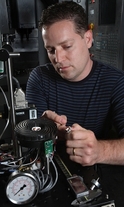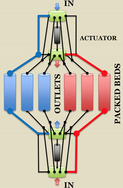 Sandia Develops Stochastic Production Cost Model Simulator for Electric Power Systems
Sandia has developed a software
toolkit that uses stochastic programming to perform power system production
cost model simulations. Named PRESCIENT, the software produces probabilistic
forecasts automatically from deterministic historical forecasts for load,
solar, and/or wind power production and their respective actuals, using a
technology known as epi-splines. The software also generates probabilistic scenarios
that are fed into the stochastic unit commitment engine.
This allows stakeholders who have no
access to probabilistic forecasts – or the expertise to generate them – to
create an explicit representation of the uncertainty in the system load, solar
generation, and/or wind generation. Because of this explicit uncertainty
representation, reserve margins and production cost can be substantially reduced,
even under high penetration of renewable energy. PRESCIENT’s stochastic unit
commitment uses an efficient technique to solve hundreds of scenarios in tens
of minutes using commercially available solvers.
PRESCIENT also has visualization
capabilities; it produces daily generation dispatch stack graphs and a cost
breakdown of commitment and fuel costs. The software was developed using Pyomo,
a python optimization modeling language developed at Sandia, and was supported
by the U.S. Department of Energy's SunShot Initiative and ARPA-e GENI program. PRESCIENT
was developed in partnership with the University of California-Davis. Graphic
illustrates an example of a probablistic solar forecast produced with
PRESCIENT.
|
 Sandia Researcher Selected as Innovator in Residence
Sandia
researcher Jeff Koplow has been selected
as the inaugural recipient of the Innovator in Residence Fellowship by the U.S.
Department of Energy’s SunShot Initiative.
The program launched on October 1, 2015, and will provide Koplow and his team
$500,000 per year for three years for innovative solar research aimed at
supporting the SunShot goal of making solar cost-competitive with other forms
of energy.
Koplow is
the recipient of four R&D 100 Awards, including one for
the “Sandia
Cooler.” He currently holds 10 active licenses on previous inventions and
has given several invited talks on the subject of multidisciplinary technical
innovation. The full story about Koplow’s Innovator in Residence award is on
Sandia’s Energy
& Climate website.
|
 Sandia Solar Researchers Available to Small Businesses through DOE SBV Program
Small clean energy
businesses can now access research support at the U.S. Department of Energy’s
(DOE’s) National Laboratories through the Small Business Vouchers Pilot (SBV), part
of DOE’s Office of Energy Efficiency and Renewable Energy National Lab Impact Initiative. Through SBV, small
businesses can be awarded vouchers of $50,000-$300,000 to be redeemed at select
national laboratories, including Sandia, for work related to nine technology
areas. The vouchers are intended to provide U.S.-based and -owned small
businesses access to unique research skills and laboratory facilities, with the
ultimate goal to move next-generation clean energy technologies to market.
Sandia is the lead
laboratory for SBV awards related to
solar energy technologies. Additional laboratories supporting solar
SBV projects are Lawrence Livermore
National Laboratory, the National Renewable Energy
Laboratory, and Pacific Northwest National
Laboratory.
SBV projects are being selected
via a merit
review process. The results of the first round of SBV proposals will be
announced in mid-December. The second round of SBV proposals will be accepted beginning in February 2016, and a third round will commence in June. SBV projects require a 20 percent cost share and are subject
to a range of eligibility requirements, including for-profit
status.
Additional information can be
found on DOE’s Small Business Voucher Pilot
website and in the site’s Frequently
Asked Questions. Informational
webinars about the program are also available.
|
Sandia Co-Authors Paper Selected as "Best of the Best" at IEEE Conference
A paper co-authored by Sandia researchers was selected at the 2015 IEEE Power and Energy Society
General Meeting as one of four “Best of the Best” papers at the conference.
“Generic
Wind Turbine Generator Models for WECC - A Second Status Report”
describes the most recent updates to the Western Electricity
Coordinating Council’s (WECC’s) generic wind turbine generator models developed
by the Renewable Energy Task Force.
Technical committees narrowed down the nearly
1,600 papers submitted for the General Meeting to 75 as “Best Conference
Papers.” Judges then selected four papers from each presentation as “Best of
the Best.” The winning papers were announced at the General Meeting Awards
Dinner. Co-authors on the paper are Abraham Ellis (Sandia), Pouyan Pourbeik (WECC), Juan Sanchez-Gasca (Electric Power
Research Institute), Jay Senthil (General Electric), and James Weber (Siemens).
Sandia Rooftop PV Structural Webinar Draws
Solar Instructor Training Network Audience
On September 22, 2015, Sandia researcher Brian Dwyer
participated in a webinar hosted by the Interstate Renewable Energy Council
(IREC) as part of its Solar
Instructor Training Network (SITN) to discuss results from Sandia’s Structural Code Considerations of Solar
Rooftop Installations and Empirically Derived Strength of Residential
Roof Structure for Solar Installations. The reports detail research
conducted by Sandia and funded by the U.S. Department of Energy’s (DOE’s) SunShot
Initiative to test numerous wood rooftop structures to failure and compare
actual rooftop load-bearing capacity data to the perceived load-bearing
capacity in building. Results indicate that rooftop load-bearing capacity is
higher than allowable loads as defined by the International Residential Code
(2009).
Dwyer, an engineer who participated in many of the rooftop
tests, discussed results and implications with the SITN audience. Nearly 170
people representing more than 125 organizations in 35 U.S. states, Canada, and
Mexico. The webinar is archived on the IREC
website.
SITN
is funded by DOE’s SunShot Initiative and managed by the Interstate Renewable
Energy Council.
Sandia Part of EPRI Research to Study PV Performance Degradation
Sandia solar researchers are part of a research
team led by the Electric Power Research Institute (EPRI) to develop novel
accelerated aging protocols for solar photovoltaic (PV) modules. EPRI was
awarded $1.3 million for the project through the Physics of
Reliability: Evaluating Design Insights for Component Technologies in Solar 2
(PREDICTS 2) funding opportunity under the U.S. Department of Energy’s SunShot
Initiative.
The project will compare performance of
actual PV panels that have been operating for a number of years to similar
panels, ideally the same make and vintage, subjected to accelerated aging. The objectives
of the project include development of an algorithm for predicting panel
performance degradation and analysis of the potential improvement to levelized
cost of electricity from improved degradation prediction.
Sandia researchers will support analysis
and evaluation of testing results for the project. Other partners include Southern
Company and Southern Research.

Sandia Researchers Team with UWisconsin to
Advance Concentrating Solar
Sandia
researchers are part of a team led by the University of Wisconsin–Madison to
evaluate the potential for significant improvements in commercial viability
of supercritical carbon dioxide (sCO2) Brayton power conversion
cycles as an option for concentrating solar power (CSP) plants. The project
is funded by the U.S. Department of Energy’s Concentrating Solar Power:
Advanced Projects Offering Low LCOE Opportunities, or CSP:
APOLLO, funding opportunity. Representatives from UW-Madison, Sandia, the National
Renewable Energy Laboratory, FlowServe, the Colorado School of Mines, and
Comprex will design, fabricate, and experimentally evaluate a 25-kilowatt
thermal switched-bed regenerator system representative of that needed
for a 10-megawatt electrical (MWe) power cycle to assess suitability with the
high static pressures, differential pressures, and thermal performance required
by the sCO2 cycle.
The focus of
the project is on the use of switched-bed regenerators for recuperative heat
transfer within the cycle, an option that initial design estimates indicate could
be less than half the cost of the current printed circuit heat exchangers. This
recuperative heat transfer can be several times the duty of the primary heat
exchanger, accounting for roughly 25% the cost of the overall cycle. Sandia
will consult on the design and fabrication of a sub-scale unit and the 25-kWth
unit, and will carry out experiments with the 25-kWth unit in Albuquerque, NM,
at the Nuclear Energy Systems Laboratory. While the current project focuses on
solar energy, the same advanced power cycle can apply to electricity generation
with nuclear, geothermal, and fossil energy. Graphic illustrates a
schematic of the team’s proposed switched-bed regenerator, to replace
conventional recuperators.
|
Sandia Discusses
Energy-Storage Test Protocols at the European PV Solar Energy Conference
Researchers from Sandia gave a plenary talk on energy storage test
protocols at the European PV
Solar Energy Conference (EU PVSEC) in September in Hamburg, Germany. Plenary
presentations are given to the entire conference and reserved for
outstanding papers that are seen as visionary in the field. EU PVSEC 2015 hosted approximately 2,500 professionals from 79
countries.
In the plenary, Sandia researchers discussed efforts to standardize
interoperability certification protocols to validate distributed energy
resource (DER) operation and communication within the power system. These
protocols will provide evaluation of energy storage interoperability and
functionality, resulting in frequency and voltage stability of DER in bulk and
local power systems.
The research is being conducted by Sandia and its collaborators in
the Smart
Grid International Research Facility Network (SIRFN)—Austrian Institute of Technology, Ricerca sul Sistema Energetico in
Italy, and the National
Institute of Advanced Industrial Science and Technology’s Fukushima Renewable Energy
Institute in Japan. The associated conference
paper discusses advanced energy-storage requirements in each SIRFN country
as well as the development of harmonized interoperable storage testing
procedures, and presents experimental results from the laboratories.
Sandia Researchers Cited in Solar
Professional Magazine
Sandia solar researchers Josh Stein and
Cliff Hansen were recently quoted in an article in Solar Professional magazine. The article, “PV
Performance Modeling: Assessing Variability, Uncertainty, and Sensitivity,”
details the importance of accurate solar photovoltaic (PV) system performance to
system design, solar financing, power purchase agreements, and other project
considerations. The article also reviews how models treat attributes such as
irradiance and temperature, soiling, wire losses, the angle of incidence, and
mismatch losses. Stein and Hansen discuss the development of future models and
the importance of being able to compare models.
External Link Disclaimer: The appearance of hyperlinks does not constitute endorsement of the external Web site, the information, products or services contained therein.
|